By Tom Demerly.
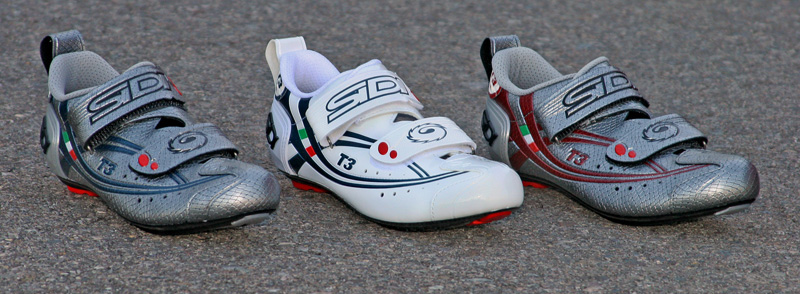
If you don’t like to read, I can save you some time: Sidi makes the best cycling shoes.
Acknowledging the sweeping nature of that statement, no one footwear brand works for everyone. It is worth educating yourself about one of cycling’s truly great brands. Like any educational process there is a great story here.
Dino Signori is, quite obviously, Italian. He lives in the Bassano de Grappa region of the Italian Alps. As a lad Dino did what most boys his age did; mountaineering, cycling, skiing. At 15 Signori began racing bicycles. And winning. But Italy is full of champions and Signori was a champion in a crowd of champions. He found escape on the bike and in the mountains though, and especially alone with his leather working tools crafting the local hides into hand made boots for climbing and skiing.
In 1960 he started a handmade specialty footwear company named for his initials, “Di” and “Si”, reversed in some traditionally Italian manner. “Sidi”.
This legacy sets Sidi apart from most other cycling and triathlon footwear brands. It isn’t some Euro-style thing, something aesthetic or subjective. Signori grew up differently, thinks differently, works differently. Because of that his shoes are different.
Sidi cycling shoes are hand made with almost no automation at a small factory in the Asolo hills of Italy. If you are a hiker or mountaineer you recognize the name “Asolo” as the famous climbing footwear brand- also born in the Italian Alps.

Signori’s approach to shoe design and manufacture is built around how a shoe can be made by hand, with hand tools. In the design process they do not consider what machines can work most efficiently to turn out thousands of shoes at the lowest cost per unit. Sidi craftsmen and women interface the care and quality control of hand processes with the full range of modern capabilities from CAD design to the most advanced carbon fibers and molded synthetic materials. Add to this the eclectic knowledge gained from hand making and fitting ski boots and the Sidi perspective on shoe design and manufacture is tangibly unique. No other cycling shoes are designed this way or built this way, completely by hand, in Italy, old world meets new.
“Nearly every modern cycling shoe innovation came from Sidi, from adjustable cleat position to Velcro closures- Sidi invented it.”
The list of cycling shoe innovation Sidi owns is amazing. Nearly every significant development in cycling shoes, from having an adjustable cleat position shoe to Velcro closures on cycling shoes, was invented by Sidi. A list of Sidi’s most conspicuous cycling shoe innovations looks like this:
- 1973: First adjustable cleat: Riders can fit their shoes to their pedals for better efficiency and reduced injury.
- 1979: First synthetic nylon upper cycling shoe: Lighter, more consistent quality, More durable.
- 1983: First Velcro hook and loop closure: Quick to don and easy to adjust while riding. Durable, lightweight.
- 1985: First mountain bike shoe: Designed for off-road clipless pedals, provides traction when walking.
- 1989: First ratcheting/ski boot style closure: Insures shoes are tight enough, can be adjusted while riding. Modular and durable. Helps customize fit.
- 1993: First monofilament style closure/adjustment: Lightweight and durable, adjustable on the fly, durable and maintainable. Spreads even adjustment over shoe at each adjustment point.
- 1999: First Replaceable lug system on MTB/Cyclocross shoe: SRS/MTB sole makes shoes last longer.
- 2002: First High Security Velcro: An enhanced, flexible, lightweight closure system that is adjustable on the fly and more durable than traditional Velcro.
Sidi boasts of additional innovations in cycling footwear, some they invented, some seen on other brands such as an adjustable heel system on road shoes. At the competitive level more bicycle races are won world wide in Sidi shoes than any other brand, an impressive metric considering Shimano’s vast distribution reach through their component business. Sidi only does footwear.
![sidi290]()
- (Left) An original, hand made Sidi Alpine ski boot. Notice the buckle closures. (Right) A tray of hand made Sidi cycling shoes awaits rigorous quality control.
Quaint beginnings aside Sidi has become a footwear and technology leader in cycling and motocycle racing. Their motorcycle racing boots are worn by moto-tourists, World Champion Moto GP riders, top motocrossers and X-Games winners. Their cycling shoes have been worn by Tour de France winners, too many winning triathletes to count and the Italian tifosiof today, a notoriously rigorous and cranky consumer. In the same way that Bell& Ross wristwatches and BMW Motorwerks have combined history, legacy, competitive performance and innovation Sidi has not only remained as relevant as they were when they started in the “classical” era before clipless pedals and carbon frames, they have remained at the leading edge of cycling and motorcycle performance footwear.
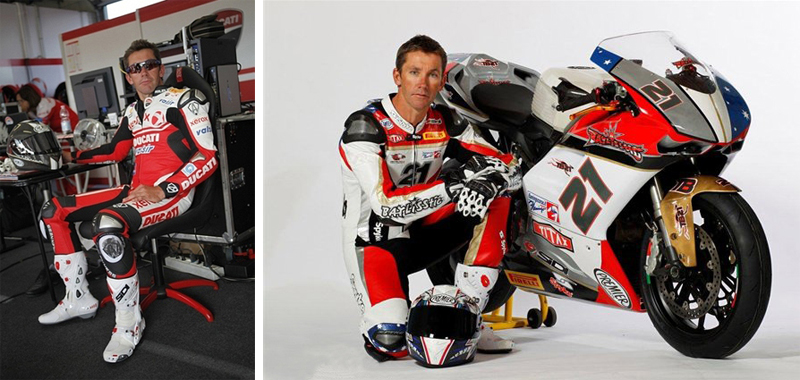
While a host of perfectly adequate mass produced, molded shoes pour out of Asia to the US market Sidi still commands a premium for performance, durability, fit, light weight and refined design than some appreciation of quiant cycling tradition. Triathletes don’t care about tradition. They want light weight shoes that transfer power well, fit precisely, leave their feet fresh for the run and last through thousands of miles of ultra-distance training and racing.
Sidi’s line up for 2012 includes a large variety of road shoes and new versions of their popular T1 triathlon shoe, now evolved to the T2 and T3, T3.6.
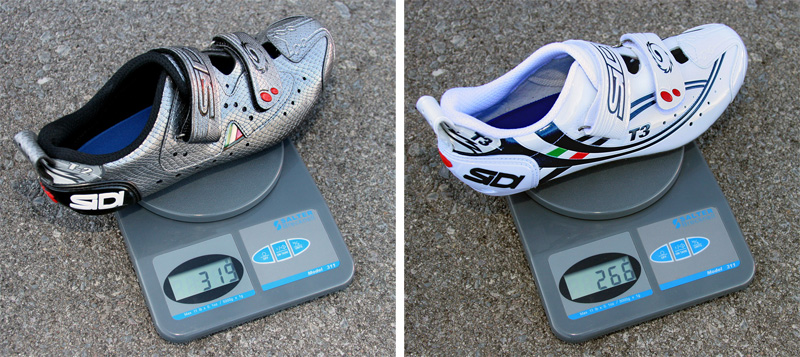
The Sidi Triathlon Shoes: T2 and T2.6 Carbon Lite.

The Sidi triathlon shoe line up starts with their classic T2. The Sidi T2 uses the more flexible and heavier Millenium 3 carbon and polymer sole.“Polymer” is the polite word for plastic. The sole on the basic T2 is a combination of injection molded plastic with small carbon fibers in the plastic during molding to add strength and stiffness. The T2 is a better, stiffer, lighter triathlon shoe than this industry had in their first two decades so this is not a low end shoe. And at $239.95 for the Sidi T2 it isn’t entry price either. Expect the excellent Sidi “T” series upper design and more sole flex than their stiffest carbon soles with a little more weight. For smaller riders this may be a more comfortable shoe, with the exception that its heavier. This is also a great shoe on larger pedalssuch as full size Look, Shimano road pedals and Time. The larger pedal platform helps moderate the sole flex if you want a lot of stiffness and you’re heavy. For light riders- it is absolutely stiff enough.
The next Sidi “T” is the T2.6. Again, same upper. Only difference here is in finish and the stiffer, lighter Carbon Lite sole.There is a hefty price bump from $239.95 on the T2 Carbon to $339.95 on the T2.6, suggesting how difficult and expensive it is to make Sidi’s high end carbon fiber soles. Is it worth an extra $100? If you are over 150 pounds and a size 42 shoe then I’ll suggest “yes”.
The Sidi Triathlon Shoes: T3 Carbon, Men’s and Women’s.
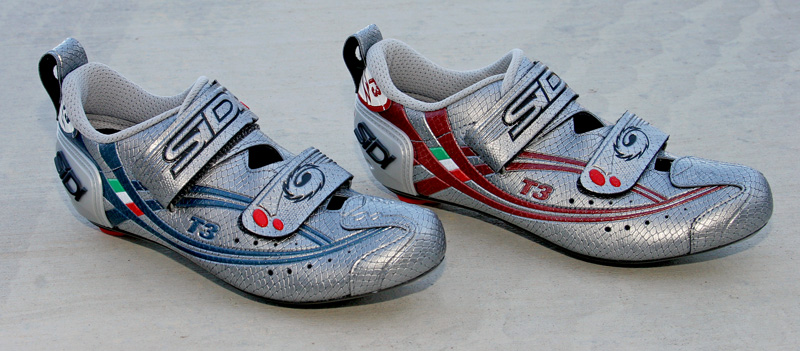
Sidi’s 2012 T3 uses their Eleven Carbon Composite sole, a sole with a variable stiffness carbon fiber insert and a molded polymer, carbon reinforced main sole. This sole design changes stiffness over the length of the shoe to facilitate comfort when worn barefoot for hours, as with an ultra-distance race where you’re on the bike for over five hours. Most importantly, the variable stiffness over the length of the shoe sole helps moderate foot discomfort during the transition from cycling shoes to running shoes. The sole is built on the standard three-hole pattern compatible with Look, Shimano Road, Time, Speedplay and other common clipless pedal systems.
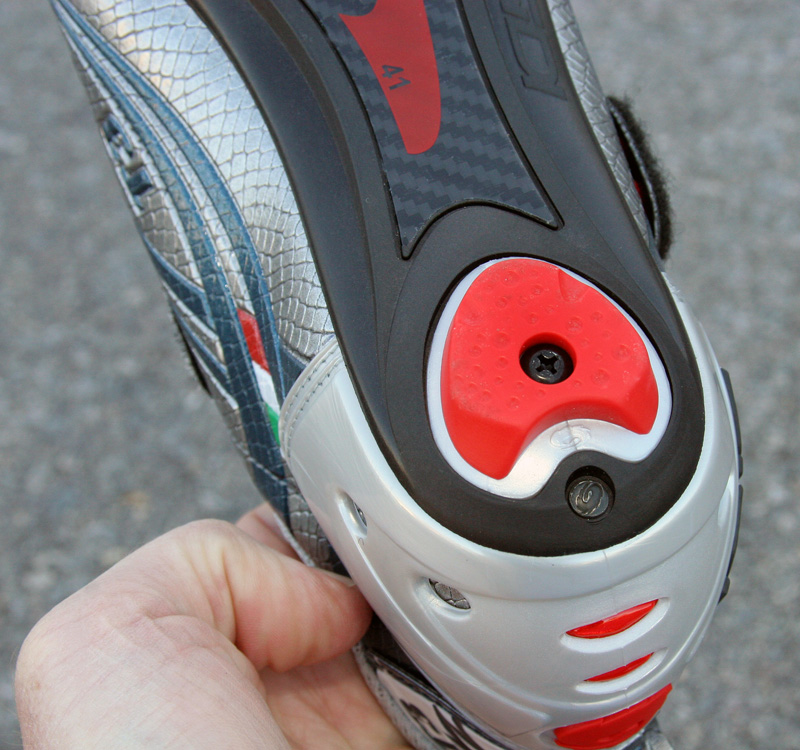
A unique and practical feature for triathletes is the replaceable heel plate made of a grippy polymer. This red heel platform helps prevent slipping when you are moving through transition areas on foot. If you use a cleat such as Time or Look with grip sections built on it your footing will be fairly secure even when jogging through transition.
The new T3 is sold in Men’s and Women’s sized versions. The Women’s version has a red stripe and logo, the Men’s version has blue stripes and T3 logo. Volume is adjusted on the Women’s shoes for female specific fit throughout the size run- they aren’t simply downsized Men’s shoes.
The heel counter is a molded cup bonded and double stitched to the upper just below the padded inner collar. The built up heel cup adds a good measure of structure to the back of the shoe where you concentrate power while pedalling. At the back of the shoe is a wide donning strap. This strap is easy to use for athletes who keep their shoes clipped to the bike in T1. It’s easy to pull the shoes on while underway since the strap is horizontal. Since the upper of this shoe is flexible it’s you can come out of the swim, jump on your bike at the mount line and pedal up to speed with your bare feet on top of the shoes. Once you are clear of the T1 mayhem you quickly slide your feet into the shoes on the go. While it takes practice to don your shoes while riding, already clipped in, it is a skill worth mastering before race day since it can save time in T1 and again coming back into T2. Of the shoes I’ve raced in since tri-specific cycling shoes have been available, this shoe is the easiest for me to don when already clipped to your pedals, leaving T1 on the fly.
The toe on the T3, like all Sidi models, hints back to the era of the toe clip and strap with a reinforced cap at the front and a more tapered toe than some other brands. While no one shoe brand fits every foot, especially since triathlon shoe fit has to be snug, Sidi’s sizing, width and inner volume seems to suit the middle 80% at least. I wear a size 9.5 US running shoe and take a size 41 Sidi T3.
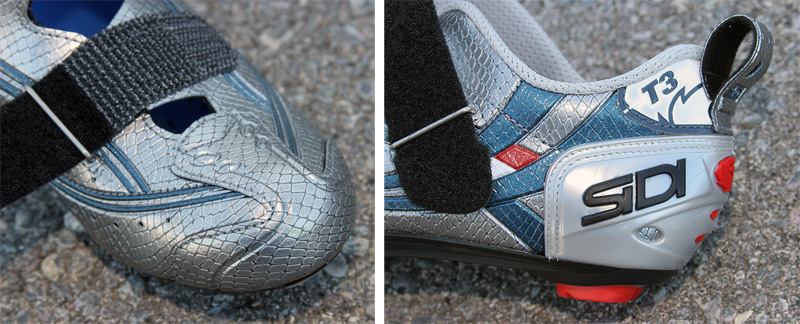
In addition to Sidi’s refined carbon fiber, variable stiffness sole the upper uses clever features optimized and evolved for triathletes. The two strap system closes in opposite directions for good volume and fit control and added comfort at Iron distance. If your feet swell after several hours on the bike you can effectively increase the volume of the entire upper by loosening both the forward (smaller) and main closure. Since the foot opening at the top of the shoe extends almost the entire length of the upper in a “burrito wrap” configuration adjusting your overall shoe fit while riding is possible. It’s a clever, simple design doing more with less.

The interior of the T3 has reduced, flat seams that run parallel to your feet. A lack of vertical seams means these shoes are designed to wear without socksfor quicker transition, more precise fit and less retention of fluids from bottles being spilled or poured over you on the bike. Having worn the previous versions of the original T1 and T2 without socks at Iron distance, 70.3, Olympic and Sprint I have never had a problem with foot discomfort in the Sidi tri shoes without socks.
Shoes are rotating weight while pedalling. It is worth paying attention to how much they weigh. The T3 is 23% lighterthan Louis Garneau’s Tri HRS shoe with the Sidi T3 at 277 measured weight in a size 42 and a Louis Garneau Tri HRS at 315 grams measured weight in a size 42. That is a substantial savings in rotating weight, well over an ounce per shoe and a combined weight savings for both shoes of 78 grams or 2.75 ounces.
The Sidi Triathlon Shoes: T3.6 Vent Carbon.
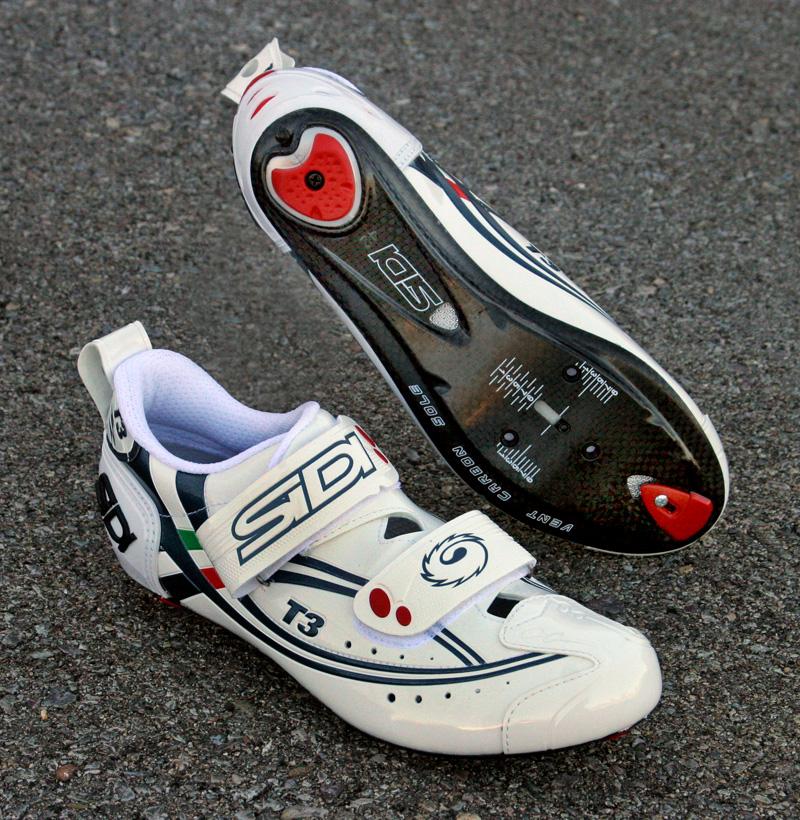
The Sidi T3.6 Vent uses a higher modulus T700 (read: stiffer) all carbon fiber molded sole for further weight savings and greater sole stiffness. The carbon fabricator is Italian and produces carbon fiber components for Ferrari and Ducati. The T3.6 saves 38 grams per pair measured weight compared to the T3, an overall 7% reduction in weight. The shoe is sold in solid white patent, a traditional colorway for triathlon shoes. A retractable drain/vent in the sole provides extra ventilation and drainage and can be closed in cold weather using the locking screw adjustment.
I’ve raced in or ridden in most popularly available triathlon cycling shoes and this shoe sets the bar. The upper, same as on the T3 except for finish, is a refined and proven design. The sole insulates the bare foot from small pedal systems and road vibration. The added performance of the full carbon fiber sole is especially relevant to large shoe sizesabove a size 44. Big feet on small pedals can use the extra sole performance. According to Sidi’s deflection test comparisons between the Vent Carbon sole on the T3.6 and the Eleven Carbon Sole on the T3 this sole is a whopping 42% stiffer on measured deflection under load.
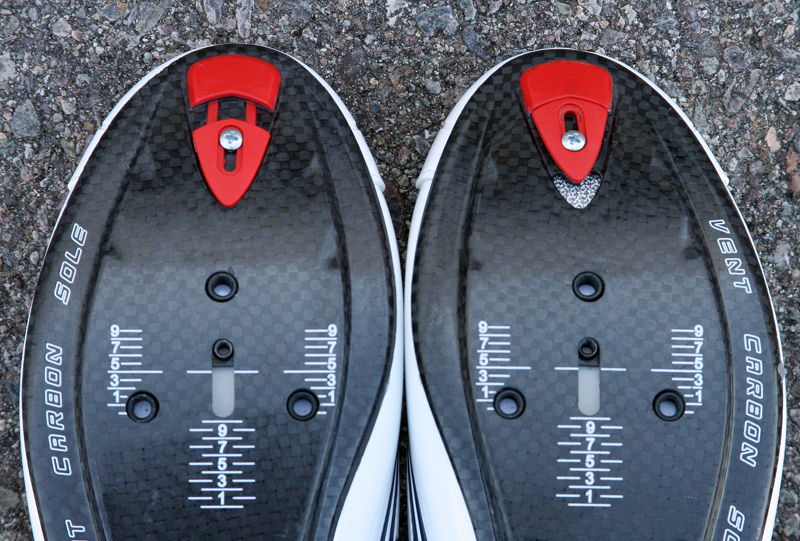
Sidi also offers an “SP” carbon sole version that uses the four bolt pattern for Speedplay pedal systems. This Speedplay-only SP sole design allows Speedplay users to get their pedal spindle closer to the metatarsal joint at the ball of your foot by eliminating the third three-hole adapter layer from the Speedplay cleat assembly. The stiff T700 carbon sole also helps moderate the small surface area of the Speedplay pedal.
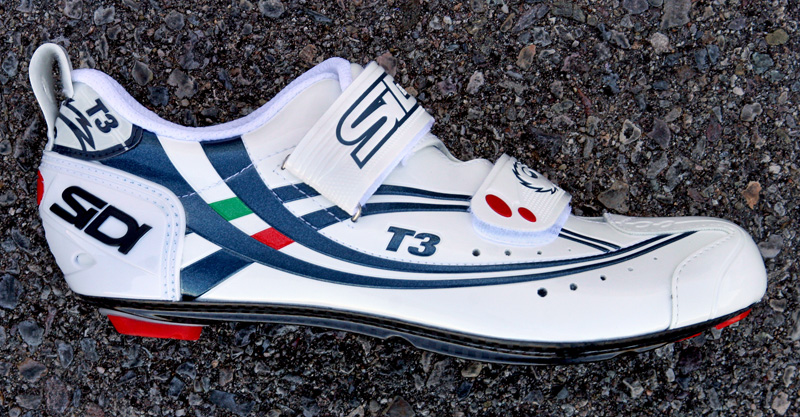
It’s difficult to appreciate how nice this shoe is without riding and racing in it. It isn’t what Sidi added to this shoe that make it great, it is what they have left off. The upper is incredibly simple, light, adjustable and comfortable. The addition of the forward Velcro strap, not used when pulling the shoe on and off in transition, allows a significant measure of adjustment for forefoot volume on the fly. Long distance triathletes know this helps prevent foot numbness. The heel counter and exotic, hand made carbon fiber sole put the stiffness where you need it and insulate the foot from vibration and the feeling of the pedal underfoot. This helps prevent foot numbness.
The decision on which Sidi traithlon shoe to buy isn’t necessarily a “good, better, best” progression. While it may seem like the $359.95 T3.6 is the “best shoe” based on price alone the $259.95 T3 with the more flexible (albeit heavier) Eleven Carbon sole is likely better for lighter riders and smaller feet who won’t benefit from the stiffer sole on the T3.6.
The Sidi Fit.
Sidi has a reputation for a trim fit. A better description may be “precise”. Acknowledging that so many triathletes buy their cycling shoes too largethe Sidi fit may feel more snug than other higher volume brands like Louis Garneau. If you want a higher volume fitting shoe then Louis Garneau and Shimano may be better choices from a fit perspective.
If you buy your triathlon cycling shoes precisely fitted and try them on at the end of the day when your feet are generally at their largest you will get a better representation of how the shoes will feel toward the end of a ride. Remember- with a triathlon shoe you are getting off the bike and running. Never stand up when trying on cycling shoes. When you stand the entire weight of your body is dispersed over the surface area of the sole of the shoe. That will never happen with cycling shoes- even when climbing out of the saddle. This is more commonly caused by the friction created when your foot moves inside your shoe. If the shoe fits precisely (snug enough) there will be no movement and, like a moderate compression garment, your feet can’t swell.
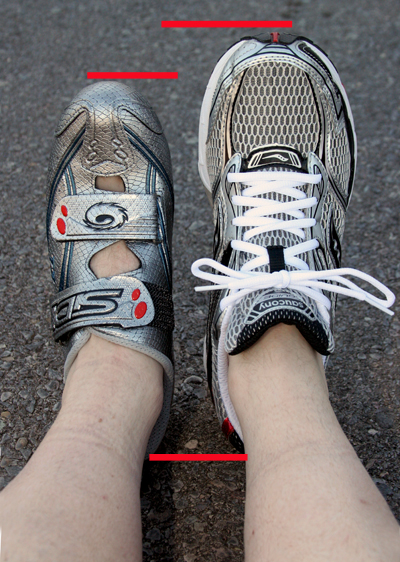
Cycling shoes that are too loose create a set of symptoms that may make them seem too small. Riders who have “hot spots” under the ball of their foot and/or numb toes or soreness when getting off the bike and beginning to run usually think their shoes are too small.

